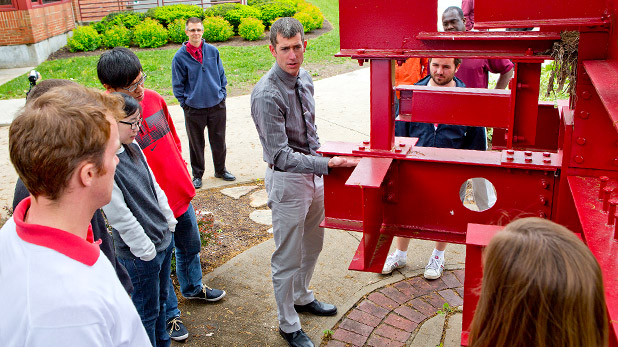Modular Learning Lab to Give Civil Engineering Department Another Learning Tool

A new modular learning laboratory will allow civil engineering students to examine how structures behave and analyze failure in steel and concrete structures.
A modular learning laboratory coming to campus in 2018 will give civil engineering students the ability to perform structural engineering experiments at or near full scale. At the same time, professors will examine how students learn civil engineering concepts through experiential learning.
Rose-Hulman is part of a three-year project, led by professors from the Saint Louis University, that’s being sponsored through a $599,821 grant from the National Science Foundation.
Assistant professor Kyle Kershaw, who specializes in foundation design, and associate professor Matt Lovell, who specializes in structural engineering, are leading the institute’s effort. The lab will also be a valuable educational tool for courses in structural analysis and design of steel and concrete structures taught by professors Jim Hanson and John Aidoo.
The lab will have a modular strong-wall testing system to which projects can be attached and tested. The system is strong enough to support simulated earthquake-strength level loads.
“This lab will be a valuable teaching tool that exposes our students to large-scale testing in order to better understand the fundamentals of civil engineering course content,” says Lovell, who teaches courses in the design of reinforced concrete, steel structures and bridges. “Students will be able to examine how structures of all construction types behave. That’s especially true for the analysis of failure in steel and concrete structures, which is a key concept to learn in an educational environment.”
Construction is scheduled to begin later this fall and should be completed in the spring of 2018. Then, professors will begin using the lab in courses during the fall quarter of the 2018-19 academic year, and study how such hands-on learning tools can enrich the teaching of key concepts in structural analysis and design.
“The lab’s versatility will be a key element to the Department of Civil Engineering and its faculty, staff and, most importantly, students,” Lovell says. “Instead of using videos to show students how beams react to the stresses being applied during an earthquake, students will be able to build multiple beams and see for themselves what’s happening in a real-world situation.”